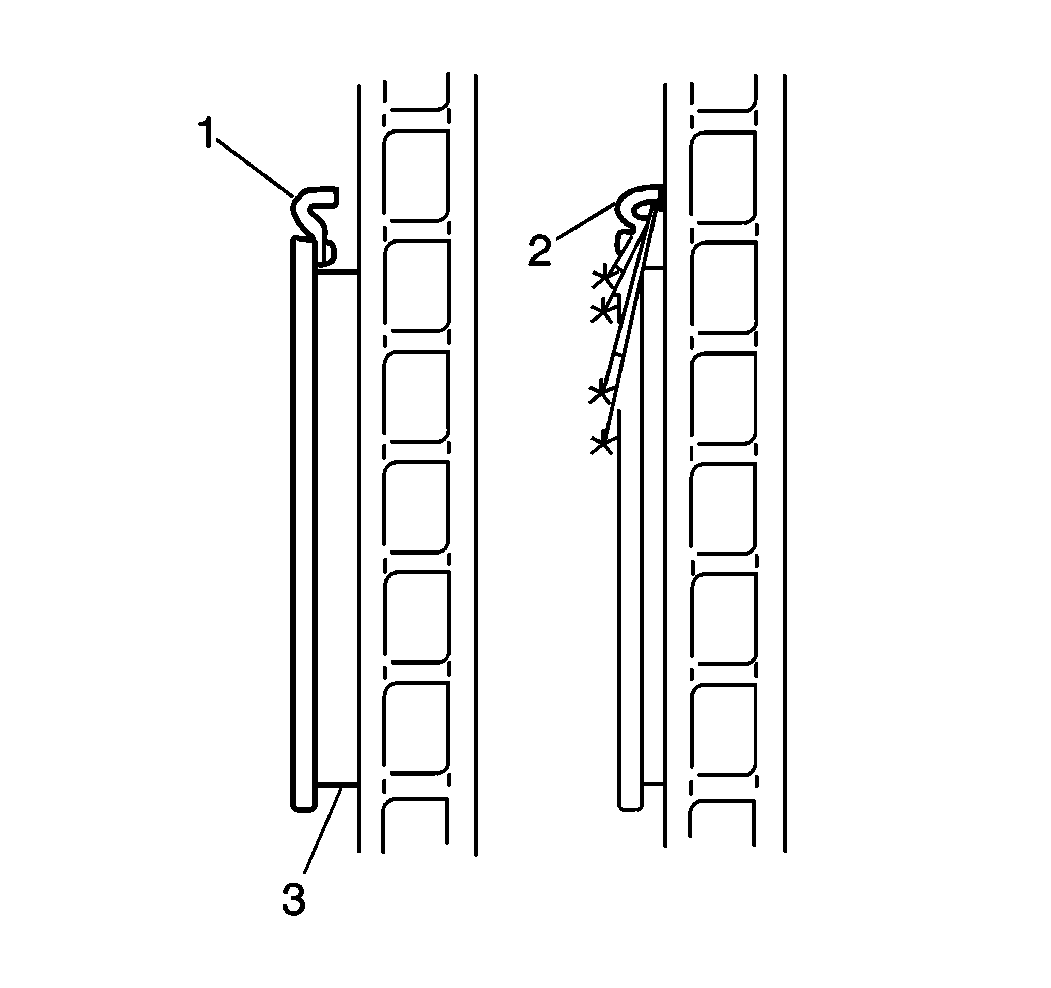Brake Pad Inspection JL9, J55, J56
Warning: Refer to Brake Dust Warning in the Preface section.

| • | Inspect the disc brake pads at regular intervals, or whenever the tire and wheel assemblies are removed from the vehicle. |
| • | If replacement is necessary, always replace disc brake pads in axle sets. |
| • | Inspect both edges of the disc brake pad friction surfaces (3). The highest rate of wear normally occurs at the trailing edge of the disc brake pads. |
| • | Inspect the thickness of the disc brake pads (3) in order to ensure that they have not worn prematurely. The disc brake pad wear should be approximately even per axle set. |
| • | Both front and rear disc brake pads have integral, audible wear sensors (1). When the disc brake pad wear reaches the minimum allowable thickness, the wear sensor contacts the disc brake rotor (2). The wear indicator will then produce
an audible, high-pitched warning noise during wheel rotation. |
| • | Replace the disc brake pads when the friction surface (3) is worn to within 0.76 mm (0.030 in) of the mounting plates. |
| • | Remove the brake calipers and inspect the friction surfaces of the inner and outer disc brake pads to ensure that they are level. Place the disc brake pad friction surfaces together and measure the gap between the surfaces. If more than 0.13 mm
(0.005 in) gap exists midway between the length of the disc brake pads, replace the disc brake pads. |
| • | Verify that any disc brake pad shims that may be required are in place and not damaged or excessively corroded. Replace any missing or damaged shims in order to preserve proper disc brake performance. |
| • | Replace the disc brake pads if any have separated from the mounting plates. |
| • | Inspect the disc brake pads friction surfaces for cracks, fractures, or damage which may cause noise or otherwise impair disc brake performance. |
Brake Pad Inspection J57
Warning: Refer to Brake Dust Warning in the Preface section.
| • | Inspect the disc brake pads at regular intervals, or whenever the tire and wheel assemblies are removed from the vehicle. |
| • | If replacement is necessary, always replace disc brake pads in axle sets. |
| • | Inspect both edges of the disc brake pad friction surfaces. The highest rate of wear normally occurs at the leading edge of the disc brake pads. |
| • | Inspect the thickness of the disc brake pads in order to ensure they have not worn prematurely. The disc brake pad wear should be approximately even per axle set. |
| • | Both front and rear disc brake pads have integral, electronic brake pad wear sensors. When the disc brake pad wear reaches the minimum allowable thickness, the wear sensor contacts the disc brake rotor and illuminates a message on the driver information
center. |
| • | Replace the disc brake pads when the friction surface is worn to within 2.0 mm (0.079 in) of the mounting plates. |
| • | Remove the brake calipers and inspect the friction surfaces of the inner and outer disc brake pads to ensure that they are level. Place the disc brake pad friction surfaces together and measure the gap between the surfaces. If more than 0.13 mm
(0.005 in) gap exists midway between the length of the disc brake pads, replace the disc brake pads. |
| • | Verify that any disc brake pad shims that may be required are in place and not damaged or excessively corroded. Replace any missing or damaged shims in order to preserve proper disc brake performance. |
| • | Replace the disc brake pads if any have separated from the mounting plates. |
| | Note: Due to the unique construction and materials of the disc brake system, some brake pad noise and dust are not considered unacceptable conditions.
|
| • | Inspect the disc brake pads friction surfaces for cracks, fractures, or damage which may cause noise or otherwise impair disc brake performance. |

